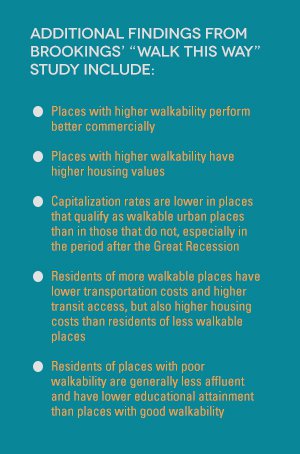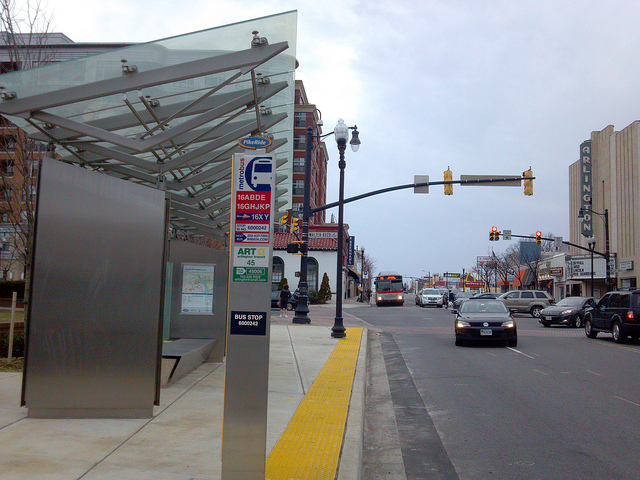Washington now that the sequester is officially here what does it mean for your community? Will you see the value of your home decrease in a similar way to the housing market crash in 2008? Hopefully not. But to answer this question you might first ask yourself if you live in a walkable urban place? That’s because during the last recession the Great Recession walkable urban places fared much better than others.
A recent Brookings study titled Walk this Way by Christopher Leinberger and Mariela Alfonzo found that walkable urban places in metropolitan Washington not only held their value better during the recession but they were among the few locations that actually experienced price increases. The study found that “on average before the recession (2000 to 2007) retail and office space in walkable urban places had a 23 percent premium per square foot valuation. During the recession (2008 to 2010) that premium nearly doubled to 44.3 percent.” The report’s authors believe a pent up demand for walkable urban places coupled with a limited supply is driving up real estate values in these communities.
 This research suggests jurisdictions with a large number of the region’s walkable communities are poised to perform better than those that don’t. The researchers see this factor tied to an oversupply of large-lot single-family communities designed solely around the automobile coupled with a limited supply of walkable communities.
This research suggests jurisdictions with a large number of the region’s walkable communities are poised to perform better than those that don’t. The researchers see this factor tied to an oversupply of large-lot single-family communities designed solely around the automobile coupled with a limited supply of walkable communities.
The Activity Center Strategic Investment Plan
With this knowledge in hand what are local governments land-use planners transportation officials economic development groups and community-based organizations doing to encourage more walkable communities? For starters many folks involved in the Region Forward Coalition recognized this emerging trend during the Activity Center update. The Coalition’s leadership encouraged staff to bring together several organizations and individuals working on the latest walkability research to develop a plan to strengthen Activity Centers through walkability investments.
The partners that are now involved in the planning project include COG’s Region Forward team Marliela Alfonzo an urban design specialist and researcher who contributed to the Brookings study Walk the Walk; Reconnecting America an organization focused on the link between transportation and community development; RCLCO a real estate economics firm; and Mobility Lab a transportation think-tank. The partners and Coalition members involved recognized such an effort would not only support economic development in Activity Centers but also help achieve critical smart growth goals in Region Forward.
When the partnership set out to develop the investment plan they utilized the latest research demonstrating the link between walkable communities and enhanced economic performance. The plan also needed to recognize that many of the region’s Activity Centers have different assets and needs and are at different stages of build out and development cycles. What may be appropriate in one Activity Center may not be a feasible solution at another given its different physical social and economic characteristics. Therefore the plan required a holistic approach which could recognize local assets and investment options for each Activity Center that would move them in a direction toward better walkablilty and economic performance.
One of the driving forces behind the plan was always the economics. Using physical and economic performance measures in Alfonzo’s State of Place Index one could easily create a plan that is primarily focused on driving up real estate values. This coupled with the fact that the affordable housing problem is already very acute in walkable communities raised concerns about equity and fairness. The Coalition and planning partners were sensitive to these issues and therefore began to examine the equity considerations and how to reasonably incorporate a focus on social equity into the investment plan.
To address this issue the Activity Center Strategic Investment Plan will create two typologies one focused on place and one focused on people to group Activity Centers based upon their shared characteristics. The groupings form the basis of the two typologies and are intended to guide the type timing and scale of investments that serve to foster equitable development and create mixed-income mixed-use walkable communities in the region’s Activity Centers.
To achieve this outcome communities will need to be mindful of how to phase in specific investments. A good example for the region is the planning effort on Columbia Pike in Arlington. Planners and local government officials are focusing very deliberately on the affordable housing equation before more placemaking infrastructure and the streetcar is built.

Columbia Pike “Super Stop” with real-time transit information and an expanded platform currently serves buses but will serve streetcar when it opens. Image credit: BeyondDC (http://beyonddc.com/).
So how do the typologies work? The first typology called the Place-Based Typology will utilize the State of Place Index to measure physical characteristics and economic performance inputs such retail sales office rents residential rents. The plan will also incorporate MetroLogic a forecasting tool developed by RCLCO to measure an Activity Center’s real estate market potential. The second typology titled the People-Based Typology will use social equity indicators that demonstrate where social equity investments may be needed.
Using the typologies the plan will identify relevant resources such capital improvement plans financing mechanisms stakeholders and partnerships needed to accelerate these investments. Another key focus of the plan is designed to inform COG and other stakeholders which include local governments transportation agencies developers and community-based organizations that can all play a role in enhancing the physical social and economic assets in Activity Centers.
The plan focuses on Activity Centers because these places have been designated locally and regionally as priority development areas and are the most likely to see the greatest level of public and private investments intended to shape the built environment. Most local governments already have a plan in place that encourages walkability in Activity Centers. But until now many local governments have never been able to calculate with some certainty the type of return on investment they might anticipate with walkablity investments.
Even with this new information the path to creating more mixed-income walkable communities will not be easy and it will take time. It will also take a commitment from a number of different stakeholders that influence the built environment. But the benefits are clear. Consumers and government are responding as many homebuyers now prefer these communities and local governments are coming to view these places as sustainable sources of property tax revenue.
Creating more walkable urban places is an approach that stands to benefit a large number of communities. However the investment plan will not be a panacea designed to solve all of the region’s economic and equity challenges. The region still has many challenges and this plan will never be a substitute for a much needed regional economic development plan. The investment plan represents just one action that can improve communities and their bottom line. In the meantime the sequester is now here. While we are still sorting through its impacts those that are invested in walkable urban places may weather this one best.
This is the second installment in a multi-part blog series by John Mataya a Regional Planner at the Council of Governments. The first installment discussed the achievements of the Region Forward Coalition and the goals for the group for the coming year.